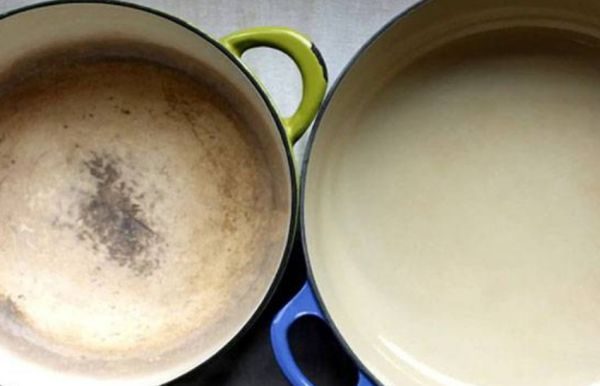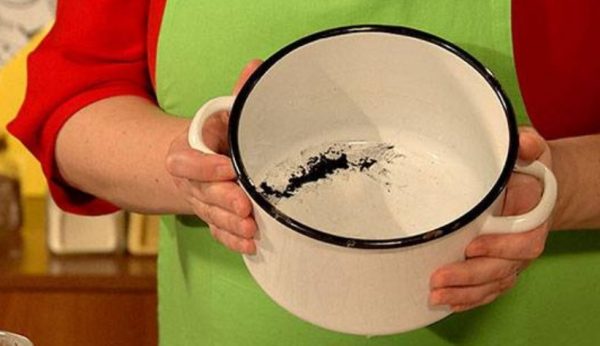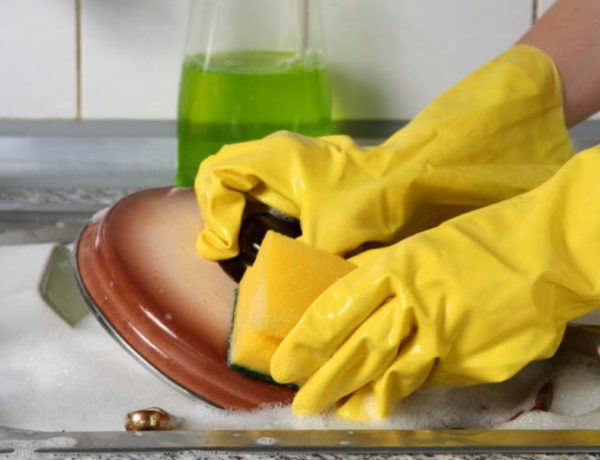How to wash an enamel pot inside from yellowness and dark plaque
Over time, enameled dishes lose their attractive appearance and become covered with dark spots. Means for washing it do not always cope with pollution; more aggressive formulations have to be used.
However, they must be used skillfully so as not to damage the top layer of the containers.
7 tips on how to clean an enamel pot from yellowness and darkening
Enamelled pans , - durable and hygienic utensils in which you can stew and cook food, getting delicious dishes.
The steel base of the product is covered with glass-ceramic enamel. Dyes are added to the composition, giving the mixture a certain shade.
Application takes place in 3 stages:
- Primer.
- Intermediate layer.
- Finish coating.
The workpieces, on which the solution is applied, are fired in an oven at a temperature of 800-850 ° C. This procedure makes the utensils durable and improves the performance of the utensils.
There are several basic rules for cleaning enamelled products.
From dark plaque
with the exception of highly concentrated. One of the handy tools available in every home is cucumber pickle.

The sponge is moistened in this liquid and the darkened areas of the dishes are wiped.
Regular apple peel is considered a highly effective remedy. Peelings from apples are placed in a container that needs cleaning, poured with water and boiled until the plaque disappears. For 1 liter of water, take the peel of 2 medium apples.
Advice ! Do not use table vinegar to clean enamel pots - it will rough the surface and leave dark marks.
From limescale
Scale formed on the walls gives the products an untidy look , stains food in an ugly color, slows down the cooking process. To get rid of such deposits, special tools are used, which are sold in the household departments of stores.
You can use a sponge and baking soda. Dissolve 2 tbsp in a liter of water. l. soda and poured into a saucepan with deposits.
Boil the solution for about half an hour, then wipe the walls with a sponge - scale is easily removed. You can also use a solution with table salt instead of baking soda.
From burnt food

Due to the low thermal conductivity, food particles often burn to the bottom of enamelled items. To prevent this, dishes are often stirred during cooking.
This is especially true for milk. If it is not constantly interfered with during cooking, it will certainly burn before boiling.
Burnt food is removed from the bottom like this:
- The container is poured with slightly warmed water.
- Pour in baking soda.
- Leave to soak (the stronger the carbon, the longer the product needs to be soaked).
- Remove carbon deposits with a sponge.
- If the walls of the dishes have darkened, use apple broth or cucumber pickle.
From yellowness
Yellowness appears on the dishes for various reasons. These can be traces of old scale that can be easily removed with a regular sponge and baking soda or cleaning powder.

If yellowness appears as a result of a reaction with some foods during their preparation, then you can use the methods used to remove dark plaque.
... It should be poured into a container to a yellow level, held for several minutes and drained. Then you need to thoroughly wash the product and leave to dry and ventilate.
Means for removing heavy plaque
Strong carbon deposits on the bottom of your favorite saucepan - not a reason to get upset or scratch the plaque with objects that came to hand. If you scratch the surface, the food will burn more often.
A proven cleanup method looks like this:
- The container is poured with water, add 1 tbsp. l. baking soda.
- Boil for 5-7 minutes over high heat, then drain the water.
- A sponge is passed along the bottom and walls, removing plaque.
Another option is soapy water. Laundry soap is grated, placed in a prepared pan with hot water, covered with a lid and left for several hours, you can leave it overnight. In the morning, they pass through problem areas with a stiff brush, removing the remnants of dirt.
The Whiteness remedy helps well. Half of the cap should be poured into a container of water, left to soak for half an hour, drained and spongeed over the problem areas. Then rinse with clean water and set aside to ventilate the remaining cleaning liquid.
Why is the enamel destroyed and what cannot be done?
Practical tips will help to keep the enameled utensils neat:
- it is forbidden to put empty dishes on the fire;
- a container with water should not be placed in the freezer - expanding, water causes damage to the enamel;
- impacts from falls are fraught with chips, which quickly become rusty;
- it is not recommended to use metal brushes and brushes for regular cleaning - they damage the coating;
- it is undesirable to use metal shovels, spoons, whisks while stirring food - they scratch the surface;
- it is not recommended to put enamelled products on a gas burner without a flame diffuser (due to spot heating, the enamel layer quickly becomes unusable);
- cookware with enamel does not tolerate sudden changes in temperature, therefore, you cannot put a hot container out in the cold or, conversely, put a cold pan on the fire immediately.
How to choose an enamel pot?
You need to buy only those products on the bottom and walls of which there are no scratches, bubbles, chips, dots, shells and sagging. It is advisable to take containers with a rim made of stainless steel - it will protect the dishes from chips when falling.
Pots with a black, beige, gray-blue or white inner surface should be preferred. Bright sides and bottom indicate the toxicity of the object.
It is better to buy products, the bottom of which coincides in diameter with the dimensions of the burner. This will ensure that they are heated evenly and will prevent cracking. You should not save on quality products - it is better to buy more expensive ones, but made to last.
Conclusion
Beautiful and comfortable dishes are always a good mood and enjoyable cooking.
In order for the pots to serve for a long time and not to spoil culinary dishes, it is necessary to clean them in a timely manner and properly care for them. This way you can preserve the taste of food and save money on buying new products.

